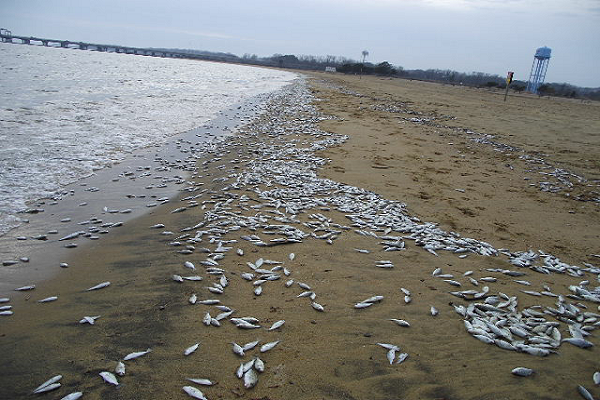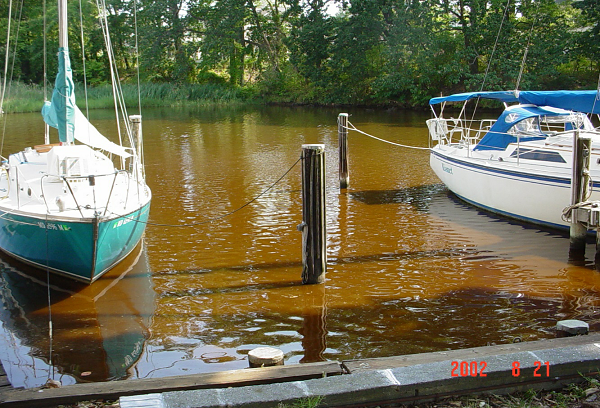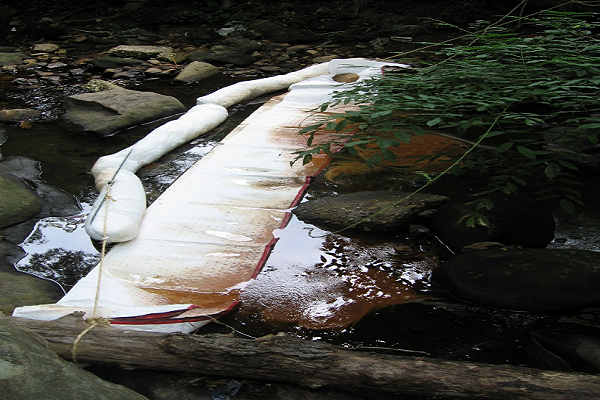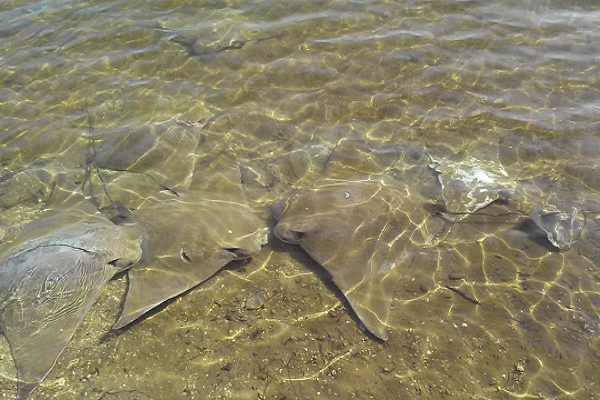MDE Fish Kill Investigation Program
Main_Content
Fish kills occur for a variety of reasons such as natural water chemistry, biological changes, chemical pollution or miscellaneous human activity.
New! 2023 Annual Fish Kill Investigations Report
MDE has the lead role in Maryland for investigating reports of dead or distressed fish or aquatic life. We ask that you
make a report by telephone because it can be responded to more quickly.
Fact Sheet:
Karlodinium veneficum and fish kills
To report a fish kill:
During Normal Work Hours: All incoming fish kill reports should be directed to the Maryland Department of the Environment's Fish Kill Investigation Section (443-482-2731) or (800-285-8195)
During Evenings, Weekends and Holidays: Calls should be directed to MEMA (1-866-633-4686). The dispatcher then immediately contacts the on call Duty Biologist from the MDE Fish Kill Response Program.
About Fish Kills: What Causes them?
Fish and aquatic animal communities have certain chemical and physical requirements that need to be met in order to survive. For example, trout require cooler water than is found in most of the State during summer. When natural physical / chemical changes in the environment occur rapidly or cause certain water quality parameters to be exceeded, fish kills can result.
- Low Dissolved Oxygen Just like people, fish require oxygen to survive. Their oxygen is dissolved in water and they use gills to take oxygen from the water. Periods of low natural dissolved oxygen (D.O.) can be caused by aquatic plant respiration at night, or as a result of oxygen demand associated with the decomposition of naturally occurring organic material such as algae. http://www.cbf.org/about-the-bay/issues/dead-zones
- Winter Kill Opaque ice and snow on ponds and lakes during winter affects photosynthesis by reducing sunlight and atmospheric exchange with the water column. Normal metabolic processes of the resident fauna further deplete the available oxygen and alter the water chemistry to critical levels. Winter Kills are not usually discovered or reported until spring, when the ice melts.
- Excessive Salinity Fish kills may occur when aquatic organisms are exposed to sudden salinity changes. This phenomenon occurs when saline waters suddenly intrude into freshwater zones as a result of tide and weather conditions.
- Temperature Aquatic organisms are sensitive to temperature extremes and sudden temperature changes. Long periods of warm dry weather may raise water temperatures to lethal levels for certain temperature sensitive, deepwater dwellers. Fish of shallow coastal waters can also be affected by overturning stratified water layers of varying temperature.

In late December 2010, two million Norfolk Spot (a warm water species) died in Chesapeake Bay due to cold stress.
Natural and Human induced factors can both contribute to changes in the biological state of the water which fish live in. Excess nutrients, global climate change, and natural phenomena can all change the conditions aquatic life live in and cause fish kills.
Algae Blooms Algae blooms often occur as a result of excess nutrients in the environment (primarily nitrogen and phosphorus). MDE also responds to and investigates reports of algal blooms (MDE HAB link). Some species (e.g. Karlodinium veneficum) release toxins that kill fish but do not adversely affect public health. Other nuisance algae species (e.g. Prorocentrum minimum, Gyrodinium uncatenum) are not known to be toxic in Maryland, but may occasionally bloom to high enough levels to cause fish kills resulting from high Bio-chemical Oxygen Demand (B.O.D). In Maryland, several algae species may produce toxins that affect public health either through direct contact with (or ingestion of) contaminated water, or through consumption of contaminated shellfish. Local algae species that constitute a public health concern include Microcystis aeruginosa, Dinophysis acuminata and Pseudonitzschia spp. These species are routinely monitored in Maryland specifically to protect public health through the MDE Beaches Program and the Shellfish Compliance Program.
http://beachapedia.org/State_of_the_Beach/State_Reports/MD/Water_Quality
http://www.marylandhealthybeaches.com/
http://mde.maryland.gov/programs/Marylander/fishandshellfish/Pages/index.aspx
Disease Humans and Animals are more susceptible to disease if they are under stress. Disease causing bacteria (http://dnr.maryland.gov/fisheries/Documents/StripedBassHealth.pdf) and parasites are always present in the environment. Environmental stress, such as rapid changes in temperature and overpopulation, can trigger disease outbreaks.
Predators Predators generally cause low levels of mortalities. Circumstances involving species overpopulation or unusual environmental conditions can incite predators to induce significant waste while preying on bait fish. Some species may kill but not eat what they kill (striped bass, bluefish). Feeding herons can injure and kill dozens of shad and herring with their beaks in a single day during their spawning runs.

In August of 2002, a bloom of the toxic algae, Karlodinium veneficum, was investigated in Back Creek, Annapolis.
Fish often don’t react well when man-made chemicals are discharged into water. Incidents such as these need to be investigated and the damage minimized quickly. At times fish kills turn into enforcement actions where damages are recovered by the responsible party. The MDE Fish Kill Response Program works regularly with sister agencies, including DNR, MDE Emergency Response Program and MDE Industrial Compliance Division to enforce Marylands Clean Water laws. Sources of chemical pollution include:
Industrial and Domestic Pollution Both industrial and domestic (sewage or chlorinated drinking water) discharges may be responsible for fish kills. Components of these discharges may be directly toxic to fish populations or may contribute to, or cause, unfavorable environmental conditions (such as low D.O. or acidic conditions).
Pesticide – Fertilizers- Pollution capable of causing fish kills may result directly from such operations as crop dusting and spraying fertilizer applications. In addition, careless cleaning of equipment after spraying can be the direct cause of fish mortalities.
Oil – Oil and other fuel discharges cause mortalities of aquatic organisms. Oil on the surface may also interfere with the exchange of oxygen from the air into the water.

In June 2007, a fuel oil discharge caused a fish kill in Long Branch in Takoma Park.
Explosive Shocks Explosives or concussion from pile driving used in construction or demolition and in munitions testing may be the cause of fish kills.
Turbine Effect Turbines used in hydroelectric plants and valves used to discharge water through dams may be responsible for fish kills. These kills may be due to mechanical injury or to sudden changes in pressure associated with passage through turbines.
Thermal Shock The release of excessively hot water or cold water from power or dams may result in fish kills near the vicinity of the discharge. Conversely, the cessation of warm water discharge from power plants during the winter can subject fish to sudden cold water shock.
Sport or Commercial Fishing Discards- Both sport and commercial fishermen occasionally discard unwanted or illegal sized fish and bait.
Combination Many fish kills may be the result of several interacting factors.

In May of 2016, these Cownose Rays were discarded by bow anglers in Smith Creek, Saint Mary’s County.
Center_Content
Other Resources
Contact Information
The Department asks that individuals who see an accumulation of dead fish in Waters of the State report it to MDE at (800-285-8195) (Days) or MEMA at (866-633-4686) (Nights/Weekends).
Maryland Department of the Environment
Water and Science Administration
Fish Kill Investigation Section
416 Chinquapin Round Road
Annapolis, MD 21401
